After many years of observing coyotes on Antelope Island I may have finally put two and two together. I’ll present the evidence and viewers can make up their own minds.
Three days ago on the Antelope Island causeway and very soon after sunrise the coyote duck hunting action began almost immediately after I got my pickup stopped. The north side of the causeway was still in the shade of the raised road so the conditions for photography were far from ideal.. Photographing moving targets in very low light is a recipe for soft shots and I got more than my share. So many of the photos below are soft but they’re good enough to document the behavior I witnessed.
For years I’ve known that late winer and early spring is one of the best times to photograph scavenging predators along the causeway. Not long after the many thousands of ducks that winter along the causeway have migrated north, Coyotes, Common Ravens, Northern Harriers and other scavenging species regularly haunt the causeway for what I’ve always called “coyote leftovers”. I’ve always assumed that those leftovers were just scraps – bits and pieces of ducks killed by coyotes that were relatively undesirable when duck prey was plentiful.
But maybe it’s more complicated than that. And more interesting. I’ll present the evidence and readers can see what they think about it.
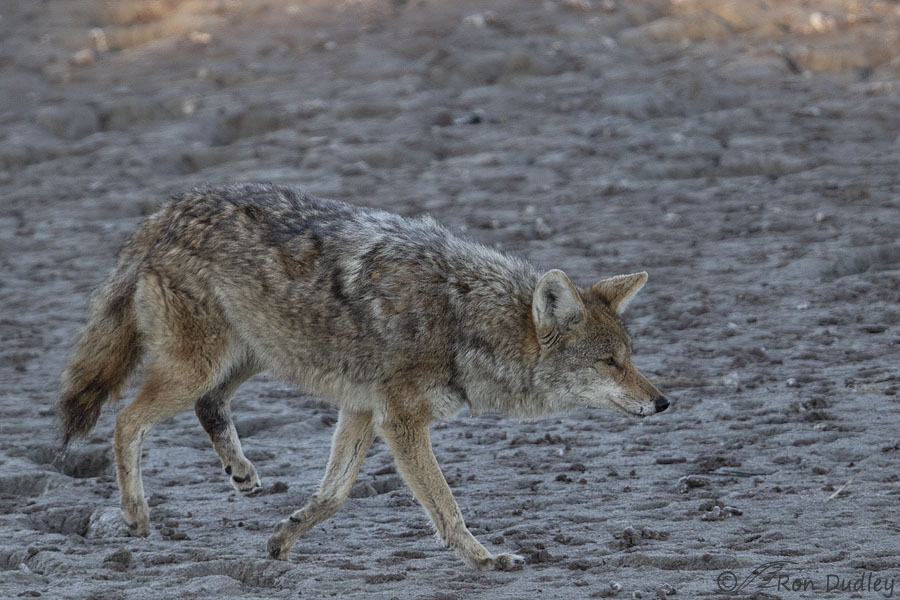
Almost as soon as I got my pickup stopped along the causeway I spotted this Coyote approaching from the west. I’m pretty sure this is the male of a mated pair that were hunting together, even though I didn’t see the smaller female until later. He was limping badly from an obvious and serious injury to the hock of his left rear leg. The area of the injury is very dark on this side of his leg but as you’ll see later the injury is more raw on the other side. I’m quite certain the leg is broken.
He was just sauntering along within about 10 feet of the shore that was lined with thousands of ducks – a mix of Northern Shovelers, Green-winged Teals and a few Northern Pintails. He didn’t seem to pay any attention to the ducks and they mostly ignored him too – they didn’t even move further away from shore as he approached. I wondered if they somehow knew he was injured and figured he wasn’t a threat. The ducks may have seen him make that walk many times before.
But suddenly all hell broke loose.
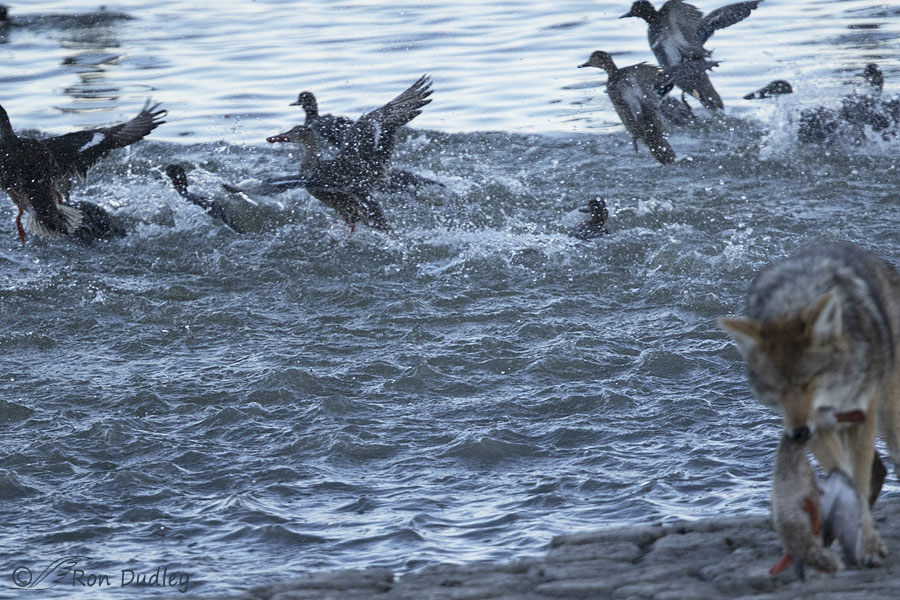
The Coyote lunged at the ducks and caught a female shoveler so easily it made my jaw drop.
It happened so quickly I barely got the scene in my viewfinder and the only thing I was focused on was the water in the middle of the frame so that’s all that is sharp Here the coyote has already turned around with the shoveler in his jaws and the other ducks are still scurrying away in what I thought at first was an out of control panic..
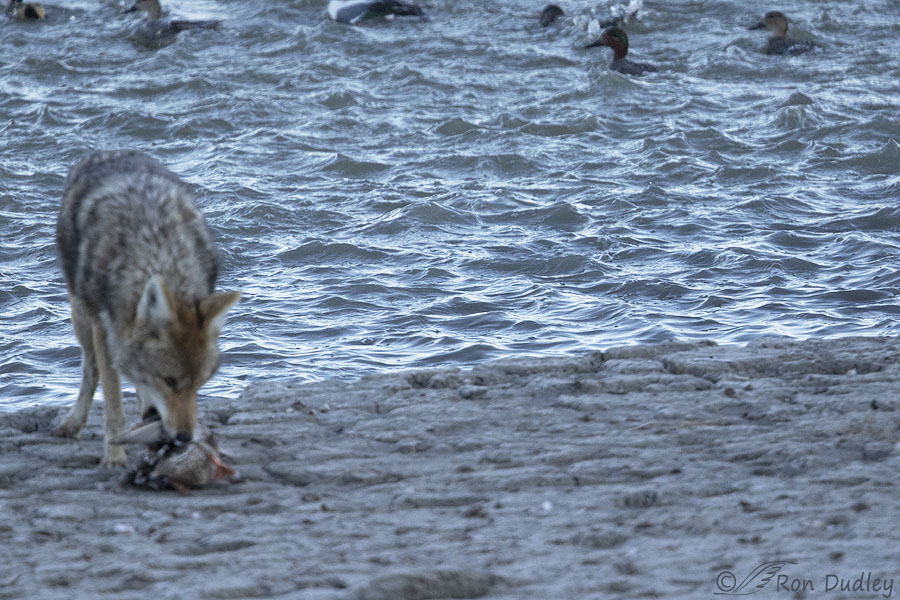
But if it was panic it was over in an instant. As we can see in this next photo the ducks didn’t fly off and they didn’t swim far. Here they’re already settling down in the water when some of them were only a few feet away from the shore and the coyote. Talk about being nonchalant with a predator so close…
The coyote isn’t eating the already dead duck. He’s only rearranging her in his mouth before…
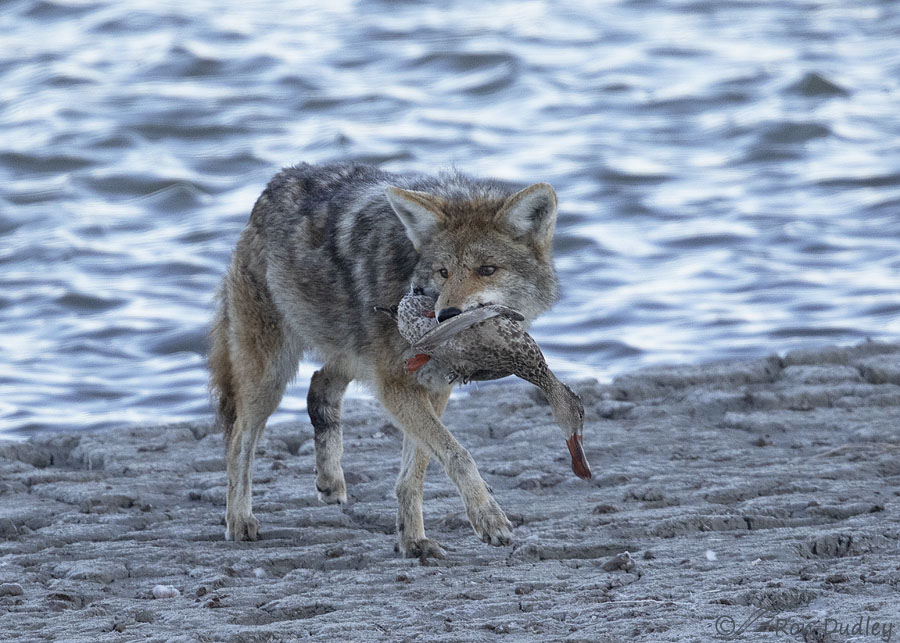
carrying her away from the shore.
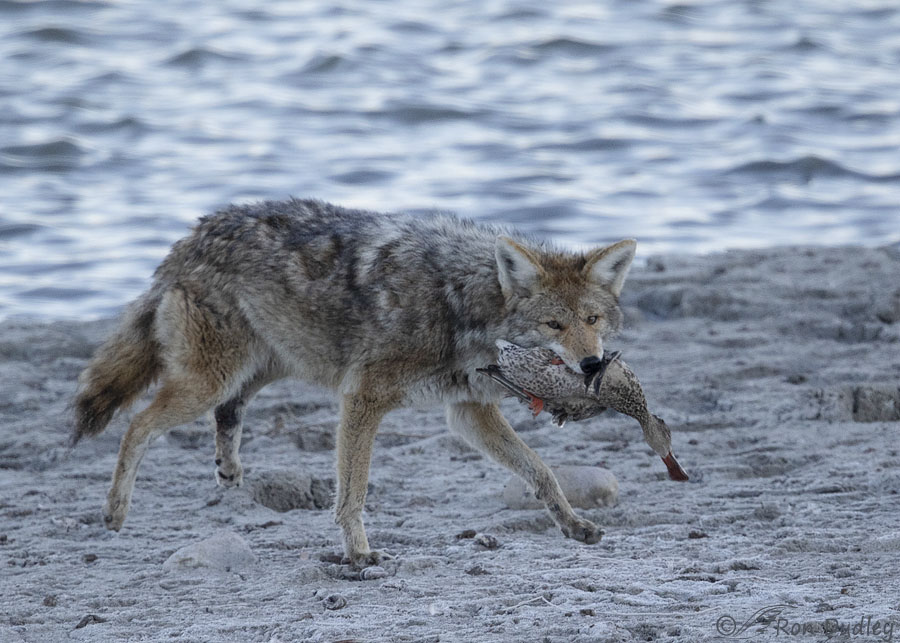
This is the last photo I got where I could see him clearly through all the rabbitbrush in front of me. But I could see him well enough to tell that he carried her up to the boulders below the nearby bridge and only seconds later he returned to the shore without her. He had obviously left her up there amongst the boulders because he sure as heck didn’t have time to eat her. Or any part of her.
He returned to the shore crowded with ducks and…
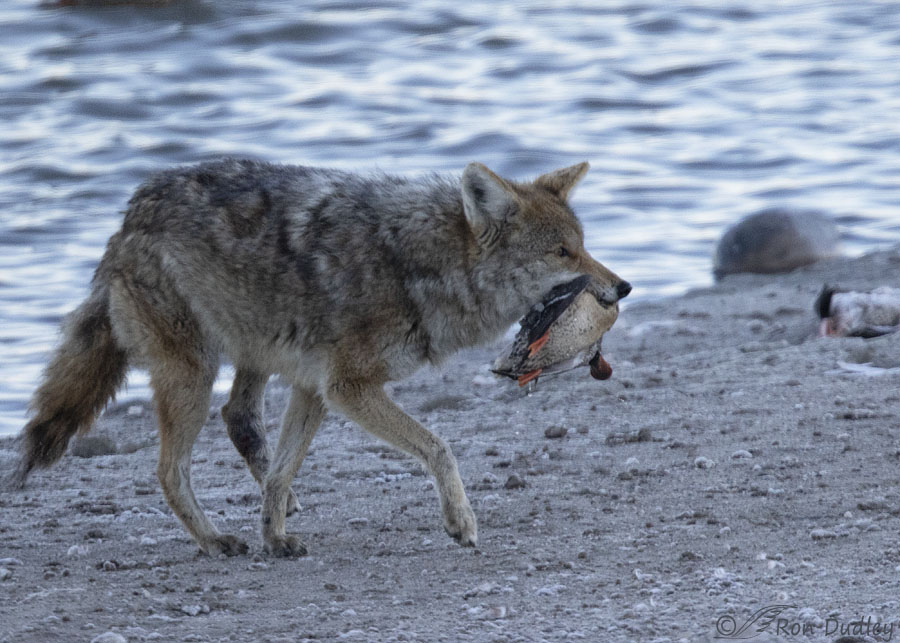
immediately caught another female shoveler with no trouble at all.
This is not the same duck as in the previous photo. Notice that his grip on her is different than it was with the first duck. Believe it or not the time stamp on this photo is slightly less than one minute later than the time stamp on the previous photo.
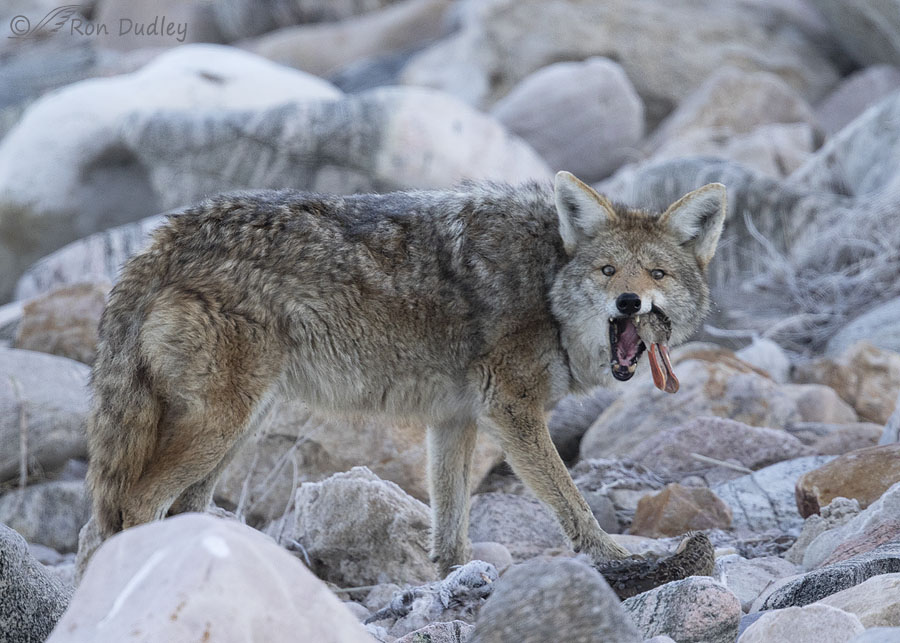
Once again he carried the duck up into the boulders near the bridge but this time I had a clear view of him. In an instant and with almost surgical precision he lopped off her head and began to swallow it whole.
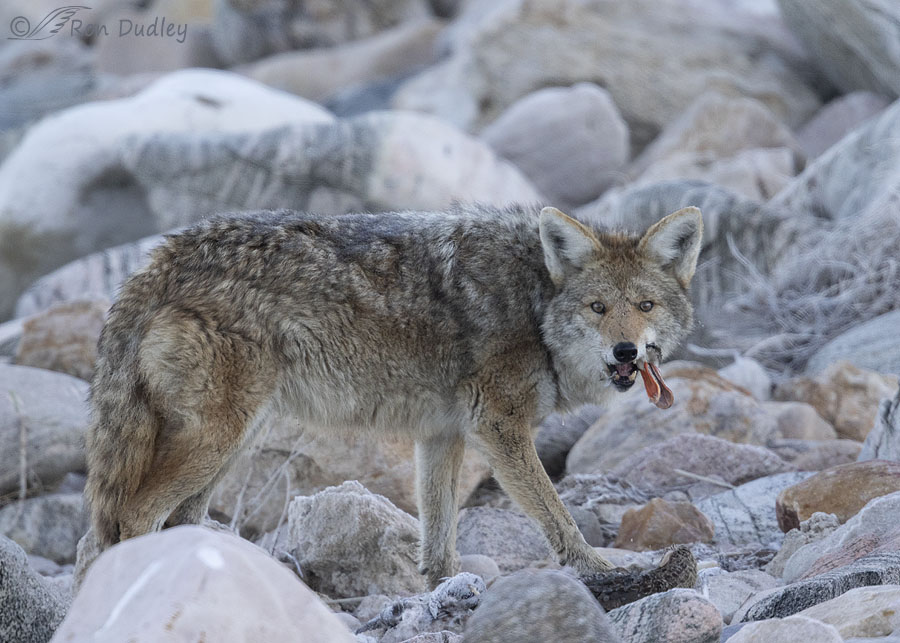
He had a tough time of it but eventually…
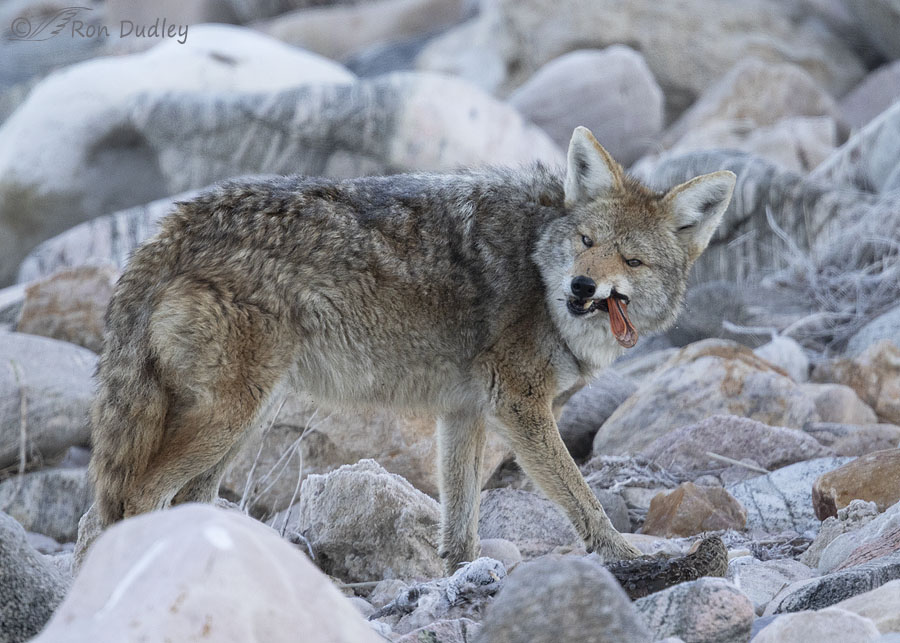
after much grimacing and and eyeball rolling he got it down. Here he’s holding the rest of her down with his right foot.
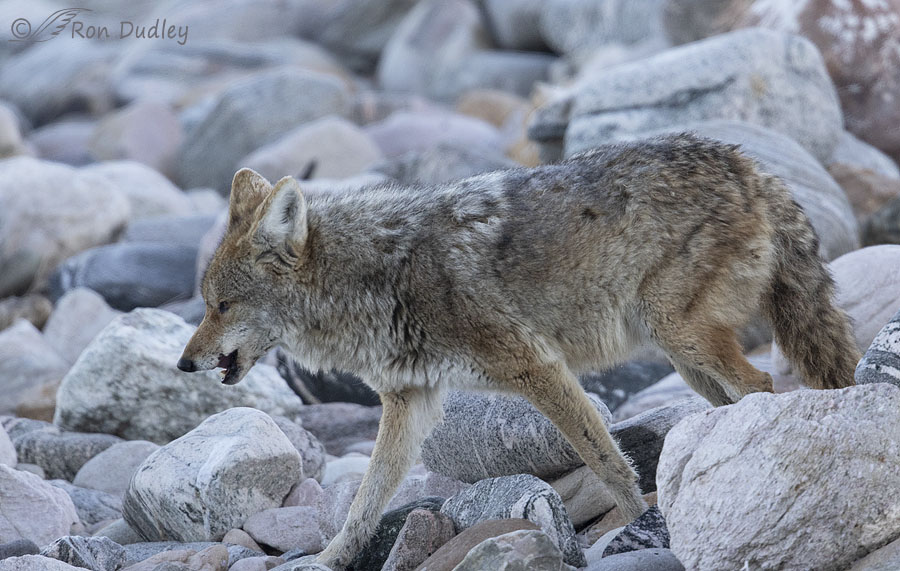
Then, still licking his chops, he walked back to shore but this time…
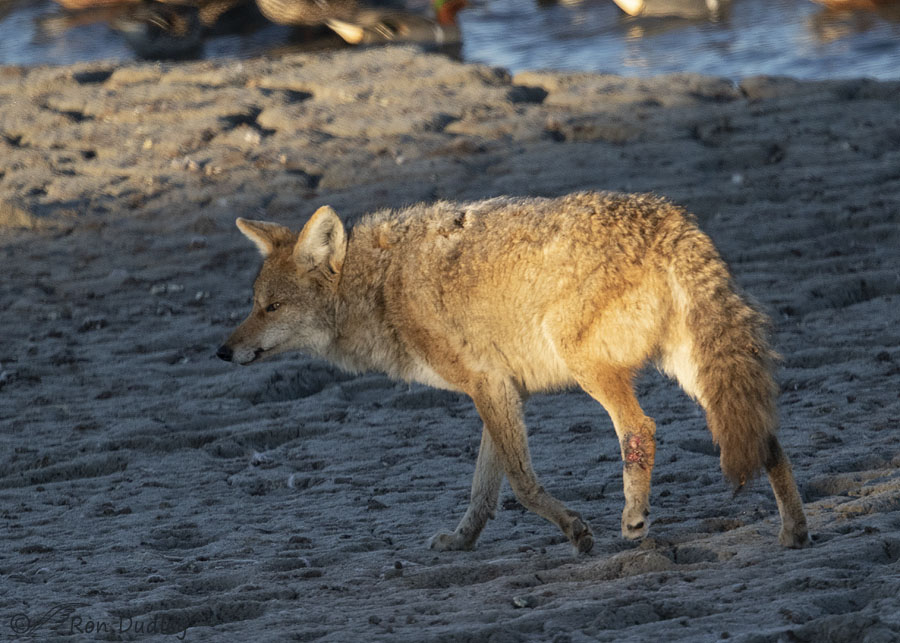
he turned west toward the island and soon he was too far away to photograph.
I’m including this blurry photo because it provides the best look I got of the injury to his left rear leg.
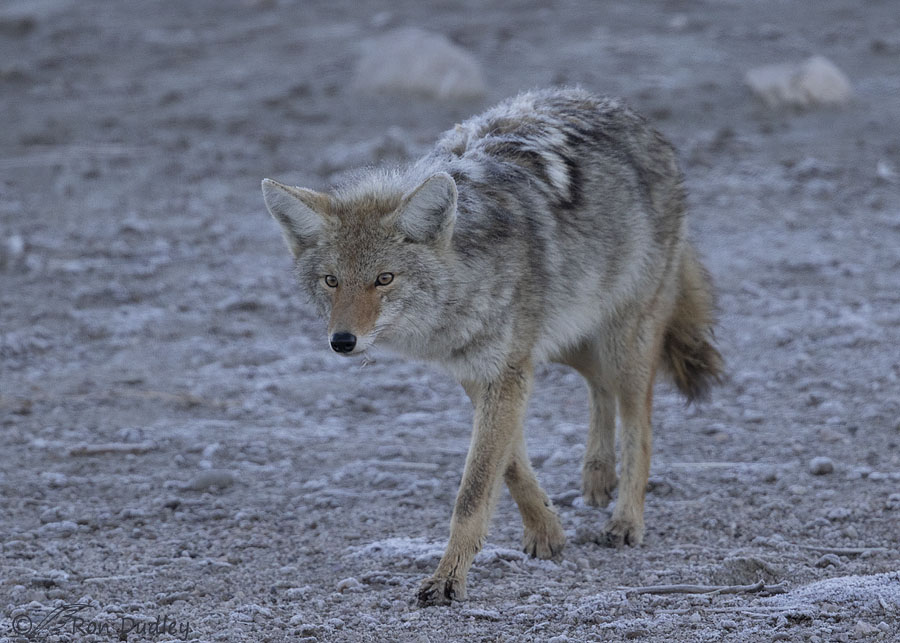
Finally I spotted his mate who had been hidden by rabbitbrush earlier. She’s noticeably smaller than he is and she has distinctive markings on her back and hackles. And her left rear leg obviously isn’t injured.
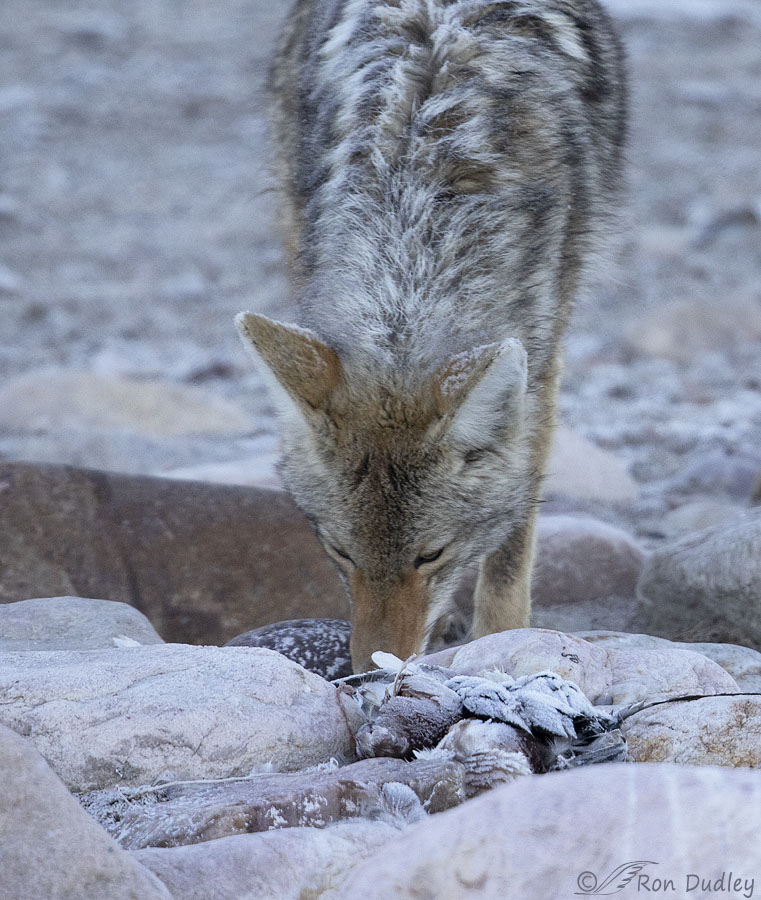
She approached me very closely to investigate another dead duck that was frozen and covered with frost.
It was at this point that I began to wonder just how many dead ducks there were in the rockpile so I started to look for them and within seconds I spotted three others. There was probably many more that I couldn’t see from the road.
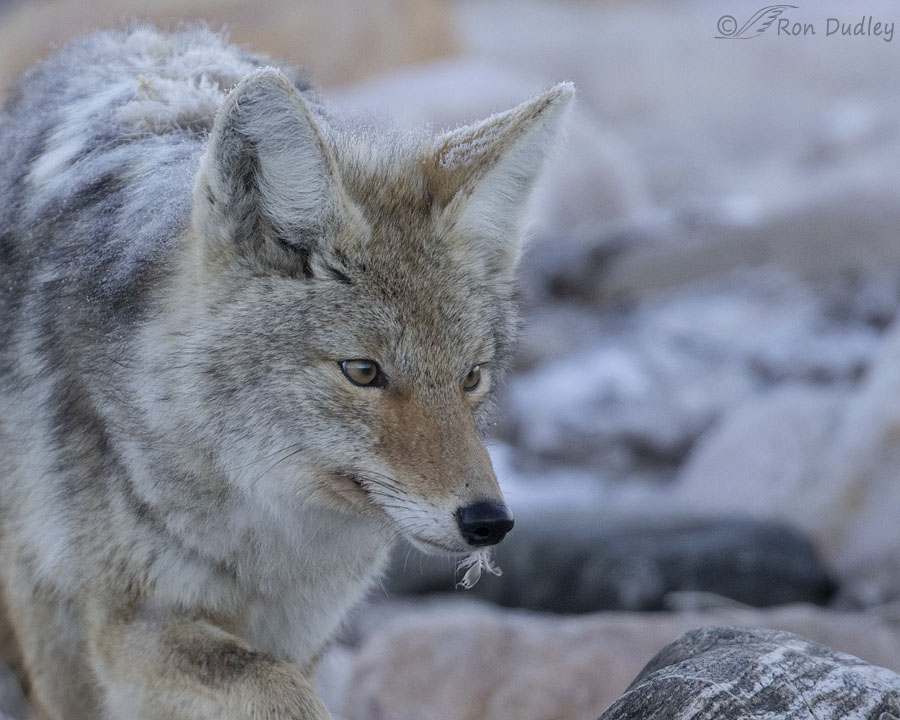
While investigating the frozen duck she got a feather stuck to her nose but she made absolutely no attempt to eat the duck. Then she turned around and followed her mate toward the island.
Like I said, in the past I’d always assumed that the duck carcasses scavengers find along the causeway after the rest of the ducks have gone north in late winter and early spring were only scraps left behind by coyotes who were gorging themselves on the earlier abundance of ducks. They ate the “best” parts and left the scraps behind.
But now I’m thinking that many of those “scraps” were actually entire ducks that had been deliberately hunted and then cached by coyotes in a time of abundance for coming hard times. And the motivation of the coyotes in these photos to hunt wasn’t the immediate gratification of an easy meal. Instead their primary motivation to hunt ducks was to cache food for later. In late winter and earl spring typical temps are still cold enough to keep the carcasses in reasonably good shape for later use.
That’s my theory anyway. Maybe some of my readers who are more coyote savvy than I am have other thoughts.
Ron


This was really interesting. It reminds me of how harsh life is out of civilization (both the wound and the duck head being swallowed down whole are pretty metal) but those coyotes are very resourceful creatures. I wonder how secure those caches are from other predators/park management/visitors.
So, I watched that same coyote fake me out this morning in that same spot. I was totally deceived by the injury into feeling sorry for that coyote and his mate. Then, BAM! He carried, cached ( or cached and carried) and later shared with his mate in a very frigid and alfresco breakfast out on the ice. Your pictures were so great! I thought I was taking some brilliant video of the whole thing, but NO. New cameras and learning curves. Sigh. At least I can look forward to your expertise.
Vwet interesting post Ron!
Charlotte Norton
Thanks, Charlotte.
Outstanding series and very informative. Well done.
Thank you, Bob.
The ability of coyotes to adapt amazes me to no end. They are certainly clever! The way the ducks spooked it made me think his mate was at the other end doing the “dog off the leash” silliness of charging into the flock.
Arwen, I don’t know where his mate was when that happened. I didn’t even know she was on the causeway until later.
So interesting! He definitely looks like he’s had his share of tough times! In the open mouth views, trying to swallow that head (!), it looks like his lower right K9 tooth may be fractured as well, and there’s some old injury there on the left side of his upper lip. His leg injury reminds me of the dog we found in NYC who’d been hit by a car – she had the benefit of surgery, pins, and great vet care, but it was still a long recovery process, and she had the scars and limped for her remaining 13 years with us. Amazing how the body copes when it has to!
I wondered about that apparent lip injury, Carolyn. Looks like he’s really been through the mill at some point.
Those images of Mr C chowing down on the duck’s head make me marvel and gag at the same time! So, the crippled coyote ain’t so crippled where it counts, and his mate knows it — she’s sticking with the guy who can provide! My best wishes to the plucky pair ….
So, the crippled coyote ain’t so crippled where it counts, and his mate knows it — she’s sticking with the guy who can provide! My best wishes to the plucky pair ….
“Plucky pair” is a good way to put it Chris. I have to wonder if the female doesn’t have pups in her belly. It’s the time of year for it.
Very interesting thought, Chris. We must not judge by the appearance of Mr Coyote . As always, Ron, thanks for a gripping narrative.
. As always, Ron, thanks for a gripping narrative.
Very interesting thought, Chris. We must not judge by the appearance of Mr Coyote . As always, Ron, thanks for a gripping narrative.
. As always, Ron, thanks for a gripping narrative.
Thought-provoking post, to say the least.
Both Mr. and Mrs. Coyote look well-fed. One wonders why the ducks seem to be such easy prey.
“One wonders why the ducks seem to be such easy prey.”
That’s exactly where my mind keeps going, Lyle. They seemed unusually, even carelessly, unconcerned about having a coyote so close. They sure aren’t that lackadaisical about it when there’s an eagle nearby.
That is a good question!
I’ve observed coyotes, bobcats and several owls species caching food. Also, during the breeding season male owls regularly decapitated their prey and eat the head before feeding the remains to the chicks. Brains seems to have a high nutritional nutritional content.
Steve, I’m not surprised at all that this coyote was caching food. Food caching in coyotes is a well known behavior. What surprised me was that his primary motivation for hunting was to capture food for caching, rather than for eating immediately and caching only the leftovers.
Downright fascinating. Mind you I am particularly blown away by the coyote ‘strolling’ along with a broken leg. I hope enough of their cache remains for them in leaner days.
I hope so too, EC.
I watched a coyote cache a duck up fairly high on the island. The duck was missing the head, neck, wings and one leg. He stuffed it into the base of a dense sagebrush clump. When the coyote left the ravens pulled it out of the sage and pulled chunks of the duck off and flew to the top of the sage branch where they ate.
Those pesky ravens. They don’t miss many tricks.
All very interesting Ron. Lots of questions, but first, can you imagine you or I walking around the rest of our lives with that leg and knowing there is nothing that can be done about it? When he ate the duck’s head did he spit out the bill or can their stomachs actually digest that? If they are stashing their cache that once again shows intelligence and the ability to plan ahead that I would not normally attribute to them. And of course if there are larger predators in the area who decide to take the cache there is not much they can do about it.
No, I can’t imagine it Everett. Especially me!
Interesting! A behavior I was not aware of tho circumstances here would make it unlikely to find a “stash”. Pheasants are probably the only bird they’d be after here (and the do take them). Road kill/gut piles are “seasonal” here and, generally, “everything” (Eagles/hawks/ravens/crows/magpies) are Johnny on the spot and competing for goodies. Of course, down in the coolies one would likely not see “how it works”. Coyotes are definitely opportunists and “survivors”….
I, too, wonder about eating the head – right up there with hawks eating the neck on a captured bird before anything else?????
“I, too, wonder about eating the head”
Judy, see tomorrow’s post for more about that. This morning I photographed more coyote behavior that may fill in some of the blanks (but I haven’t seen the photos yet so time will tell).
Who knew coyotes cache food?! Love to see the guy can hunt like a pro with his injured leg.
Actually Kathleen, food caching is a coyote behavior that has been known for some time. The caching didn’t surprise me. But hunting for the exclusive purpose of caching did.
Although I’ve never observed this deliberate caching behavior, I would never
underestimate the intelligence of a coyote……sometimes I think that jealousy
motivates the vindictive behavior of so many( anglo) humans toward this animal…..
interestingly to me, the many myths told by Native Americans about the cleverness of coyote were seemingly NOT also told about wolves—maybe
because they’re more fearsome to humans ?
Or maybe because they were able to observe coyotes more closely and more often than wolves. I dunno, Kris.
Fascinating post. Thank you.
Thanks, Ann.
Enjoy your photos and comments. You might find SURPRISE: Lens Hoods Can RUIN Cold-Weather Photos (VIDEO) by Ron Leach to be of some interest.
Thanks, Dow. I’ve seen that video. And removing my hood doesn’t seem to make a difference.
Wonderful post, Ron, and full of learning for me. And what beautiful dogs. I want so badly to intervene and somehow get that male some help for his injury. This I know to be the human inclination that has done so much harm to critters. But it is just so damn impressive, don’t you think? To just get on with what needs to be done in spite of hurting.
I spent 20 some years rehabbing wildlife, and they break your heart, with their courage and their hardships. But we had many broken bones heal and the sufferer returned to the wild. Many breaks heal on their own. We got in a raccoon who’d been hit by a car.. He didn’t make it, but he had a fully healed very old leg break. And I’ve found bones of deer and other animals showing old healed breaks.
Reason for some optimism, Sallie.
I sure do “think”, Cathryn. Impressive indeed.
This was a fantastic series of images! I really hope the Coyote survives. I guess as long as there is the Shoveler buffet, his will be just fine.
René, I was out there again this morning and most of the ducks are now gone. Hopefully this male coyote will fare OK, even without an easy and abundant source of food.
Incredible photos and post. Really intriguing!
Thanks, Kellie.
Very interesting. Thank you.
Thanks, Steve.
Really, really good post, Ron. The shots may be documentary quality but are first class documents of behaviour and together with your speculations make for great food for thought, esp as it tied in to my own observations on grey squirrels caching and retrieval this morning.
Thank you, Granny Pat.
I absolutely love this post! Excellent explanation that I completely agree with.
It makes absolute sense and in fact we know of other animals that store food. Why not predators? Terrific shots and wonderful post! Many thanks!!
Dick, I’m not surprised at all that this coyote was caching food. Food caching in coyotes is a well known behavior. What surprised me was that his primary motivation for hunting was to capture food for caching, rather than for eating immediately and caching only the leftovers.
Very interesting Ron. Caching makes sense. The ample supply of sitting ducks allows the coyotes to save for later
I am curious about them eating the heads of the ducks? Did you notice if all the cached ducks, or the majority of them, were missing their heads? In Katmai when the salmon are easy to catch the bears will eat the brain first, often leaving the rest of the carcass. The brain is high in fat calories in salmon.
Great observations. Are leghold traps allowed in Utah? Wondering if the injured coyote was a victim of traps? I hope he survives without too much pain.
Ed, tune in tomorrow for more on coyotes eating duck heads. This morning I got more photos of the behavior. I haven’t seen the photos yet but many of them should be pretty good.
Utah allows trapping but not on the island or the causeway or anywhere else nearby.
It makes sense… except, what prevents ravens and others from taking *all* of the cached ducks? (Sorry if this is a stupid question. I have big gaps in my understandings.)
Cheryl, nothing prevents it but in my experience they all seem to get their share. No single scavenger species finds them all.